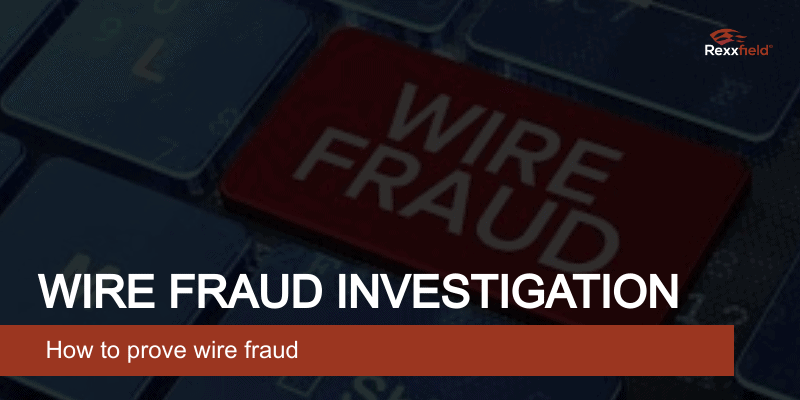Wire fraud investigation to prove wire fraud
Our cybercrime investigators have the global expertise and resources needed for wire fraud investigation to help you gather the proof you need. We use a full range of investigative strategies to investigate cybercrime and identify anonymous users behind cybercrimes for a wire fraud investigation.
How do you prove wire fraud?
During a wire fraud investigation, you need to identify certain elements to assist the prosecution in obtaining a conviction. A prosecutor has to prove the following elements beyond a reasonable doubt:
- The defendant participated in a scheme to defraud someone, to obtain money or something else of value through pretenses;
- The defendant acted with intent to defraud;
- The defendant used fraudulent representations as part of the scheme to defraud; and
- The defendant used wire, radio, or television communications in interstate or foreign commerce.
Sometimes, people can be convicted of wire fraud even if they didn’t defraud anyone or personally used fraudulent wire, radio, or television communications. You must prove that the defendant planned to deceive someone or knew that wire communications were being used to make false statements. It is also enough for the state to prove that the defendant caused the use of a wire transmission to commit or advance the fraudulent scheme, even if the defendant didn’t intend the transmission if it was reasonably foreseeable “in the ordinary course of business.” See Pereira v. United States, 347 U.S. 1, 8 (1954).
Our cybercrime investigators can assist with gathering the proof needed.
Help me investigate wire fraud
 Definition of wire fraud:
Definition of wire fraud:
Wire fraud is a crime in which an individual plans to defraud or take money based on false representations or promises. The fraud takes place over the phone or involves electronic communications and is either across state lines or internationally. Authorities consider wire fraud as a criminal offence under federal law.
Wire Fraud Statute:
Congress created the wire fraud statute in 1952 to expand the scope of mail fraud laws. This statute covers fraud committed using communication methods other than mail.
The wire fraud statute Section 1343:
Whoever, having devised or intending to devise any scheme or artifice to defraud, or for obtaining money or property by means of false or fraudulent pretences, representations, or promises, transmits or causes to be transmitted by means of wire, radio, or television communication in interstate or foreign commerce, any writings, signs, signals, pictures, or sounds for the purpose of executing such scheme or artifice, shall be fined under this title or imprisoned not more than 20 years, or both.
If the violation occurs in relation to, or involving any benefit authorized, transported, transmitted, transferred, disbursed, or paid in connection with, a presidentially declared major disaster or emergency (as those terms are defined in section 102 of the Robert T. Stafford Disaster Relief and Emergency Assistance Act (42 U.S.C. 5122)), or affects a financial institution, such person shall be fined not more than $1,000,000 or imprisoned not more than 30 years, or both.
Examples of Wire Fraud.
Wire fraud cases include a large range of fraud-based offences, like insurance fraud, tax fraud, or bank fraud. This is because a critical element in mail and wire fraud prosecutions is how fraudulent statements are communicated. A list of wire fraud investigations from the Internal Revenue Service (IRS) shows a wide range of cases. The list involves statements made to investors in an alleged Ponzi scheme, allegedly fraudulent claims on a warranty for business equipment, as well as electronic bank transfers allegedly intended to advance a tax evasion scheme.
Mail Fraud
Wire fraud and mail fraud have many characteristics in common. Like wire fraud, a mail fraud conviction needs proof that the defendant intentionally engaged in a scheme to commit fraud. But what differentiates the two is the use of wire vs. mail.
Mail fraud is frequently charged alongside wire fraud in court cases. This is because fraudulent communications are often made through various channels such as phone calls, emails, and mail.
Mail fraud is – just like wire fraud – a federal crime. The penalties for mail fraud can be up to twenty years in federal prison and/or a fine. Fraud involving a presidentially declared disaster, emergency, or federal financial institution can result in a prison sentence of up to thirty years.
Internet Fraud:
Fraud carried out through email or other means on the internet is referred to as “cybercrime.” Common types of cybercrime are hacking and phishing to unlawfully acquire financial information or computer data. Crimes are often prosecuted as wire fraud when email is used to commit fraud. Cybercrimes that are not prosecuted as wire fraud can be prosecuted under federal or state law.
Securities Fraud:
The charge of securities fraud covers a wide range of fraudulent schemes that involve investment securities, including the sale or purchase of securities. Authorities can charge securities fraud alongside wire fraud in some situations, such as a scheme that involves investment securities as well as the use of wire communication.
Because securities fraud is both a federal and state crime, there are substantial penalties that can lead to up to ten million dollars in fines and a prison sentence of up to five years. For federal securities fraud, this prison sentence can increase to up to twenty years.
Are banks liable for wire fraud?
The Uniform Commercial Code (“UCC”) administers liability for unauthorized wire transfers. Under the UCC, banks are liable for unauthorized wire transfers from non-consumer accounts unless the bank and account holder agree to use a commercially reasonable security procedure to verify wire transfer requests before sending. If the bank and depositor agree to this, and the bank sends a wire after verifying the wire transfer request, then the depositor is liable. However, the bank only avoids liability if it accepts the payment order in good faith after verifying. So for a bank to avoid liability, it must
1) agree with the account holder to verify wire transfer requests with a commercially reasonable security procedure, and
(2) follow that procedure in good faith.


 Definition of wire fraud:
Definition of wire fraud: